Discovering Authentic Beaujolais Vineyards and Traditions
Nestled between Lyon and Mâcon, the Beaujolais region offers visitors an intimate journey through centuries-old winemaking traditions and breathtaking vineyard landscapes. According to France’s tourism board, wine-related visits in Beaujolais increased by 22% in 2024, reflecting growing interest in authentic cultural experiences.
What makes this region truly special beyond its famous wines? The answer lies in discovering family-run domaines where passionate vintners share stories passed down through generations, especially during events like the beaujolais nouveau festival 2025.
Also to read : Unveiling sheffield’s steel legacy: key insights for exploring britain’s industrial past
The Heart of France’s Most Celebrated Wine Villages
The cobblestone streets of Fleurie wind through vineyards that have been tended by the same families for generations. This village, crowned by its iconic chapel, embodies the romantic spirit of Beaujolais wine country. Here, stone houses with terracotta roofs create a postcard-perfect setting where time seems to move at the rhythm of the seasons.
Just a few kilometers away, Morgon reveals a different character entirely. Its rolling hills are dotted with traditional Beaujolais cellars, where local vignerons still practice age-old winemaking techniques. The village square comes alive during harvest season, when the air fills with the sweet aroma of fermenting grapes and the laughter of workers sharing stories over communal meals.
Also to discover : Discover stratford-upon-avon’s secret gems: an in-depth journey into british literary heritage
Moulin-à-Vent stands as the crown jewel of the region, its historic windmill watching over endless rows of Gamay vines. The village’s medieval architecture tells stories of centuries-old winemaking traditions, while its narrow alleys lead to family-owned domaines where passionate vintners share their craft with genuine pride and warmth.
Why These Wines Stand Apart from Other French Vintages
The Beaujolais region creates wines that dance to their own rhythm, thanks to the remarkable Gamay grape and centuries-old winemaking traditions. While Burgundy relies on Pinot Noir and Bordeaux champions Cabernet Sauvignon, Beaujolais has perfected the art of crafting wines from this unique varietal that thrives in granite soils.
The secret lies in carbonic maceration, a traditional technique where whole grape bunches ferment in sealed tanks filled with carbon dioxide. This process creates the signature bright fruit flavors and low tannin structure that make Beaujolais wines so distinctive and food-friendly.
The region’s terroir tells a compelling story through its diverse soils. The northern crus benefit from granite and schist foundations, producing complex, age-worthy wines, while the southern areas feature clay and limestone that yield the fresh, vibrant styles perfect for immediate enjoyment.
Unlike the formal structure of many French wines, Beaujolais embraces an approachable elegance. These wines celebrate pure fruit expression rather than oak influence, making them perfect companions for both casual gatherings and sophisticated dining experiences throughout the seasons.
Essential Wineries and Cellars to Experience
The Beaujolais region offers an exceptional collection of family-run domains and historic cellars that showcase centuries of winemaking tradition. From intimate tastings in medieval stone cellars to panoramic vineyard tours, each experience reveals the unique character of this renowned wine region.
Here are the must-visit wineries that exemplify authentic Beaujolais hospitality:
- Domaine Marcel Lapierre – Pioneer of natural winemaking in Morgon, offering guided tastings that explain biodynamic methods while sampling their celebrated Cuvée Marcel
- Château des Jacques – Historic estate in Moulin-à-Vent with underground cellars dating from 1741, featuring premium cru tastings paired with regional charcuterie
- Domaine Jean-Marc Burgaud – Family domain in Régnié specializing in small-batch productions, where visitors can meet the winemaker and explore traditional fermentation techniques
- Cave de Fleurie – Cooperative cellar representing 80 local growers, perfect for discovering diverse expressions of Fleurie wines at accessible prices
Most domains welcome visitors by appointment, with tastings typically lasting 45 minutes to an hour. Many offer harvest experiences during September, allowing guests to participate in traditional grape picking alongside local families.
Planning Your Perfect Visit to This Enchanting Region
The magic of Beaujolais unfolds differently throughout the seasons, making timing crucial for your perfect escape. Spring and early autumn offer the most enchanting experiences, with mild temperatures ideal for vineyard walks and outdoor tastings. The famous harvest season in September transforms the region into a bustling celebration of winemaking tradition.
A three to four-day stay allows you to truly savor the region’s essence without rushing. Begin your journey in the charming village of Fleurie, then wind through the rolling hills to discover family-owned cellars in Morgon and Moulin-à-Vent. Each cru reveals its unique personality through intimate tastings with passionate vintners.
Transportation from Lyon couldn’t be more straightforward. The regional train connects you to Villefranche-sur-Saône in just 30 minutes, where local buses and rental cars open doors to hidden gems. Consider staying at one of the region’s welcoming chambres d’hôtes, where morning conversations with your hosts often lead to the most authentic recommendations and exclusive cellar visits you’ll treasure forever.
Cultural Traditions Beyond the Vineyards
The heart of Beaujolais beats strongest in its village squares, where generations of winemaking families gather to share stories that stretch back centuries. These moments reveal the region’s true character—one shaped by ancient traditions that extend far beyond the celebrated vineyards.
Local festivals punctuate the calendar with authentic celebrations that welcome visitors into the community fold. The harvest season brings traditional grape-picking ceremonies where families work side by side, their songs echoing through the rolling hills. Village bakeries still follow recipes passed down through generations, creating regional specialties like coq au vin beaujolais and andouillette that pair perfectly with local wines.
Artisan workshops dot the countryside, where skilled craftspeople create everything from hand-blown glass to traditional pottery. These encounters offer genuine connections with locals who are eager to share their expertise and family histories. The region’s cultural heritage lives in these everyday interactions—whether you’re learning about traditional barrel-making techniques or discovering why certain feast days remain central to community life.
The true beauty of Beaujolais cultural immersion lies in these unscripted moments that transform a simple wine tour into a meaningful journey through French rural tradition.
Your Questions About Beaujolais Wine Tourism

What are the best wineries to visit in Beaujolais?
Domaine de la Madone in Fleurie offers exceptional tastings with panoramic vineyard views. Château des Jacques in Moulin-à-Vent provides premium experiences. For authentic family-run establishments, visit Domaine Chignard in Fleurie or Domaine Jean-Marc Burgaud.
When is the best time to visit Beaujolais for wine tasting?
September through November offers the harvest magic with vibrant colors and active vineyards. Spring (April-May) provides pleasant weather and blooming landscapes. Winter visits allow intimate cellar experiences with winemakers sharing their craft.
How do I get to Beaujolais from Lyon?
Drive 45 minutes north via A6 highway to Villefranche-sur-Saône. Regional trains connect Lyon Part-Dieu to Villefranche in 35 minutes. Organized tours from Lyon include transportation and eliminate driving concerns after tastings.
What makes Beaujolais wines different from other French wines?
Beaujolais uses carbonic maceration, creating fruity, light wines perfect for early drinking. Made exclusively from Gamay grapes, they showcase fresh berry flavors and minimal tannins, contrasting with Burgundy’s structured Pinot Noir wines nearby.
Are there guided tours available in the Beaujolais region?
Professional guides offer cultural immersion experiences combining wine education with local traditions. Tours include vineyard walks, cellar visits, and authentic meals with winemaker families. Half-day and full-day options accommodate different interests and schedules perfectly.


